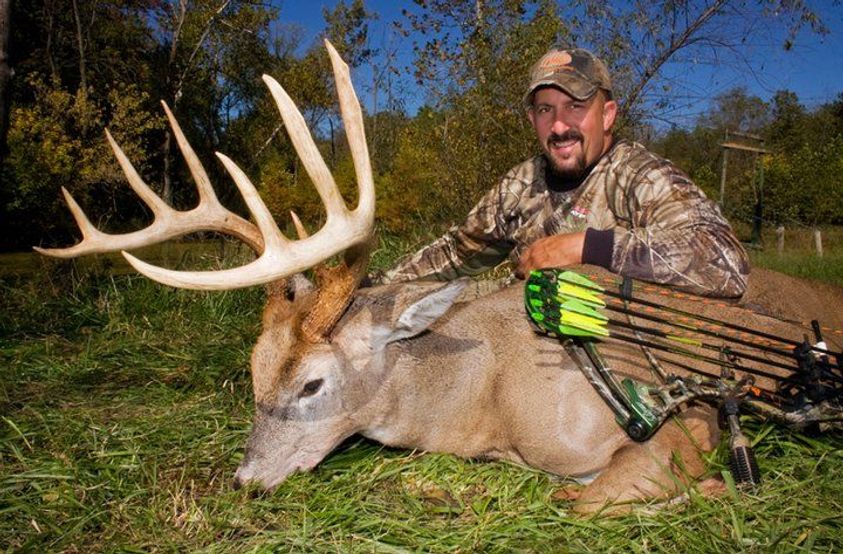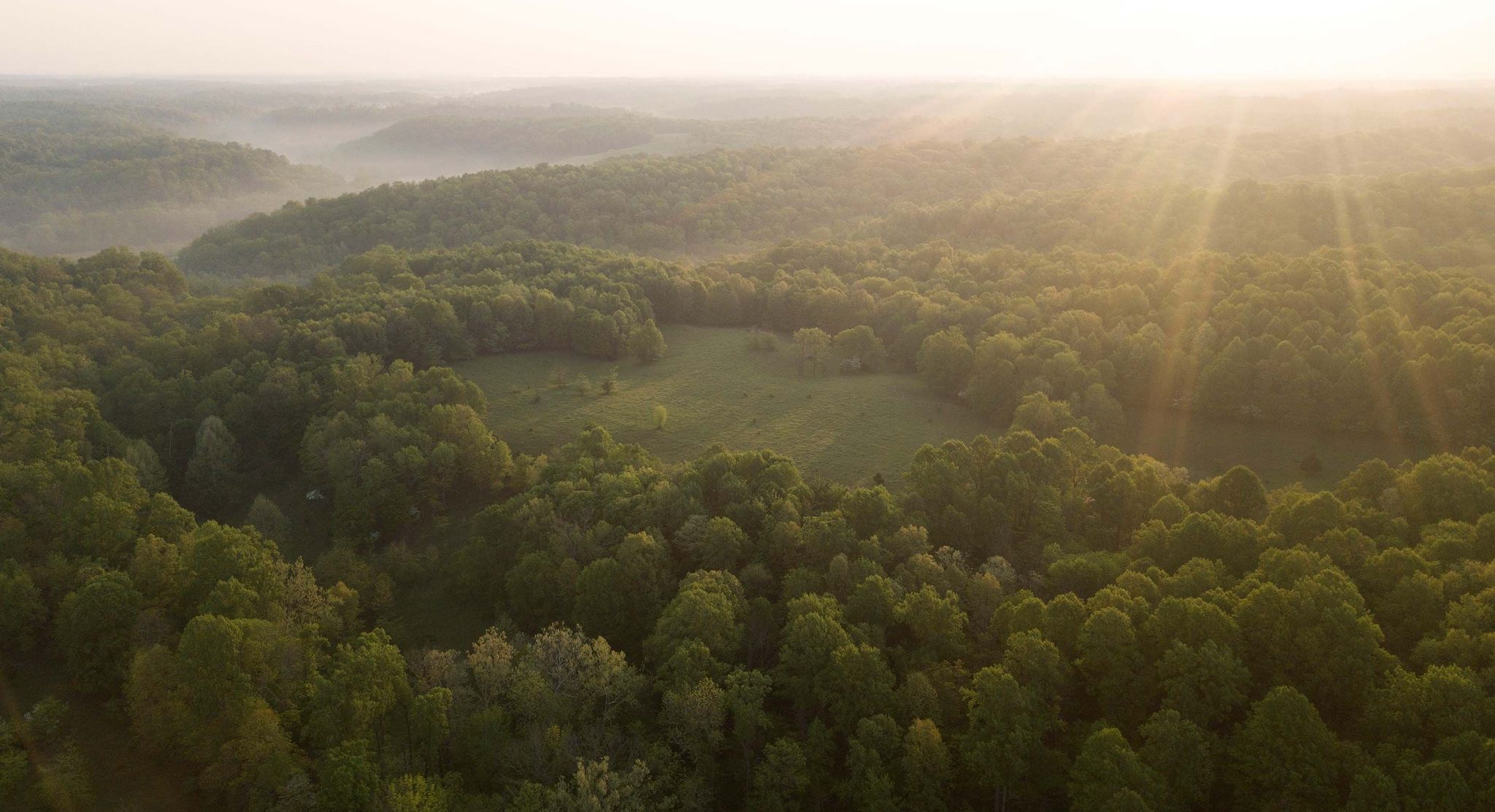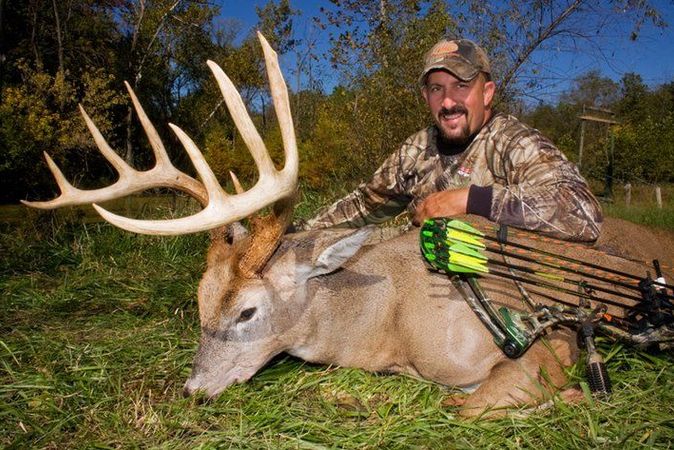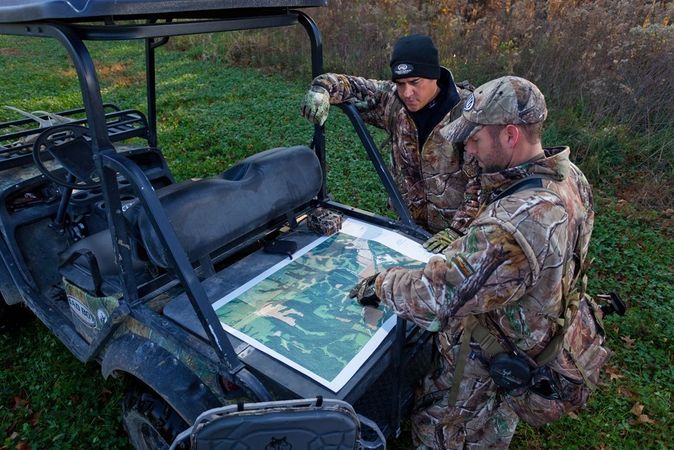The picked bean field was speckled with large and small running tracks. It was the 17th of November and chances were good that these tracks indicated the presence of a hot doe! Past rut hunting experiences reminded me that fleeing does and pursuing bucks frequent water. Considering it had been a pretty dry season, I headed down to a spot where the creek paralleled the bean field.
Sure enough, there were several beaten-down trails leading away from the field to a low spot in the creek bank where deer could easily quench their thirst. There was only one problem, except for a couple of small fractures where deer managed to paw through the ice, the creek was frozen solid. With no time to waste, I hurried back to the truck and grabbed a tree stand, steps and a shovel (for breaking through the ice).
After a short deliberation, I decided on a straight huckleberry tree that would put me in position to intercept most of the trails and the creek itself. The stand site I selected was only about 30 yards into the timber, allowing me a perfect opportunity to slip across the bean field without bumping any deer or leaving scent on any high foliage. Everything looked good, so I quietly vacated the area brimming with high hopes and anticipation.
To my accord the weatherman forecast five-mile an hour southwest winds. This spot was too hot to risk altering deer movement by trying to slip in during the obscurity of pre-dawn. Therefore, the following morning I hunted one of my other southwest wind stands until mid-morning. At 10 a.m., I climbed down, got a bite to eat and headed for the creek. It was 11 a.m., when the shrilled barks of an alarmed fox squirrel warned of my intrusion. Now perched 25 feet above the forest floor I could clearly see the heavily tracked water’s edge surrounding the rift I’d made through the ice.
With two turkey sandwiches in my pack, I was ready to spend the day. At 11:15 a.m., I noticed several does out in the field being chased by a juvenile eight-pointer. Then a little past noon, a doe and two yearlings came to the creek. Shortly after, they were followed by another doe and a respectable 110-inch, 11-pointer. The only thing he lacked was age. I remembered thinking, “If he makes it, he’ll surely be a keeper next season.” The buck got a drink then proceeded to run all the other deer away.
The next hour or so was quiet. A 1:45 p.m. the action picked up when I spotted a wide, 140-inch 10-pointer trailing a doe across the field. About the time I lost sight of them, a doe followed by the same young eight-pointer worked their way past me to the creek for a drink.
Over the next hour three more young bucks and several does came and went. Then at 3 p.m., two does timorously trotted down to the creek. What got my attention was that these two does approached the creek from a different direction than I’d anticipated. Just as soon as either of them would bend for a drink, they’d lift their heads up and check their back trail. You could cut the tension with a knife…crack, snap, urrp, snap, urp…a buck was coming, grunting with each step.
I stood in my tree stand, took a deep, cleansing breath and snapped my release aid on the string loop. Seconds later, he trotted into view, nostrils flared, testing the air for intoxicating fragrance of an estrus doe. It was the wide 10-pointer I’d spotted earlier out in the bean field chasing does.
The buck’s heifer-thick neck extended outward and low to the ground as he headed toward the does. The 10 tines of his symmetrical rack pointed upward like pitchforks, glistening in the afternoon sun. The does watched nervously as the buck took one last whiff before losing interest and moving up the creek bank in my direction. Already at full draw I waited until his chest entered a small clearing less than 10 yards away before turning loose a razor sharp Sidewinder Aero Head.
The crimson covered arrow buried in the ground was all that was left to mark the spot where the buck just stood as he whirled and ran. Just as he made it to the field’s edge the big buck staggered to the left and then to the right before crumpling on the ground. The rut, what an exciting time to be in the timber!
Although this period may vary across North America, throughout most of the northern regions, it usually starts around the 10th of November and runs until Thanksgiving (give or take a couple days).
During the primary rut bucks are completely engrossed in finding receptive does. It is this lusting rage that makes them most vulnerable during the rut. Two or three weeks prior to this period, during the pre-rut stage, scrapes are very useful in deciphering buck travel. And, two or three weeks prior to the pre-rut period, setting up along an active rub-line is a great plan of attack. During these earlier periods bucks are somewhat predictable.
Unfortunately, many hunters don’t realize bucks abort their patterns as soon as does come into estrus. Hunters fail primarily because they continue to use pre-rut tactics. When bow hunting the primary rut, I jettison rub-lines and scrapes and concentrate on hunting doe family units because bucks are hunting doe family units. A great place to locate doe family units is in and around primary food source.Rather than seeking out fresh scrapes or rubs, the most important deer sign I look for is what I call “buck chasing doe tracks.” Such a find is represented by large and small running tracks together. This is a good indicator that there’s a hot doe in the area.
AMBUSH SITES
When prowling for receptive does, it’s not uncommon for a buck to cover 10 to 15 miles in a single day. I believe one of the reasons bucks are most vulnerable during this period is because their travels often lead them out of their familiar core area.
Many big bucks leave their home court in search of receptive mates. The lingering aroma of an estrus doe is enough to make a big buck do careless things. From doe family bedding area to bedding area, these love-crazed bucks seek potential partners. This is why hanging stands which overlook funnel situations are such hot prospects, especially funnels that connect bedding areas. This is a great plan for morning and midday hunts.
However, on evening hunts I prefer stand hunting funnel situations that connect bedding areas to feeding areas. Although bucks are more interested in locating hot does than they are in feeding, does are still on their same feeding patterns. Hence, these crazed suitors will follow a potential mating partner anywhere. It’s this eagerness to pursue a sweet-smelling doe that also makes bucks more vulnerable during this period. This is why it’s not uncommon to catch a gigantic buck lusting for an exasperated doe out in the middle of a wide-open field at 10 in the morning! During no other period would a mature buck make such a foolish mistake.
A funnel is any situation along a whitetail’s range that tapers his travel options. Yes, it would be nice and simple of every funnel resembled a perfect hourglass with a narrow strip of cover linking two enormous bodies of timber. If you are fortunate enough to find such a situation, that’s super, but more often than not, funnels can be very subtle.
A funnel is much like the neck of a pop bottle. Imagine that the large part of the bottle is an area where deer bed, and the outside of the bottle is an area where deer feed or vice versa. Now consider the neck of the bottle is actually a low spot where deer can cross a high banked creek. If that low spot is the easiest place to cross the creek for some distance, then a funnel is formed, thus tapering the whitetail’s travel options from the large body of the pop bottle to the narrow neck of the pop bottle. The same thing would happen if that low spot where deer crossed the creek was a low spot along a stretch of high fence or solid strip of ground between two sloughs. There are many different situations which create a funnel.
Throughout this period I also key in on places where whitetail can water in and around primary food sources. Although hunting watering holes is much more popular out West, hunting watering spots can be very effective across the rest of North America as well. That is, of course, unless there is too much standing water, like many areas down in Florida, Louisiana and Mississippi, where much of the whitetail’s habitat is covered with water.
However, here in the Midwest where I hunt, if there’s been a lack of rainfall and it’s approaching the peak of the rut, watering areas that are in or near major food sources.
Picture this: The rut is in full swing and old mossy horn has been running ridges and chasing does out in the fields all night. As the sun starts to peak over the horizon, many does filter back through the timber towards their bedding areas. By now the old buck is pretty worn out from the night’s prowl, and he’s ready to rest. Then around eight a.m., he’s back on his feet. With his flared nostrils reaching skyward, the big buck tests the air for the seductive juices of an estrus doe. Soon, he’s back at it. Like busting up a covey of quail, the old boy moves in and does the flushing. Up one ridge and down the other they go. Temporarily, they’ve given the buck the slip. First a yearling doe wanders down to the pond to get a drink, they her twin, followed by a mature doe. Before long, several other deer wander down to the pond for refreshment. Suddenly, the does are alerted by the melody of a lovesick buck, “urp, urp, urp.” Each grunt sounds closer than the last. Minutes later, a 1 ½ year old four-pointer comes into sight. The does skirt his advances, but it’s clear they’re not leaving.
Abruptly, a doe assumes a point position. With her ears forward and body tensed, she stares back into the timber. Shortly, all of the deer, including the young buck have assumed a statue like posture as they also stare back into the timber. The crunching of leaves confirms the intruder is getting close. Then like a raging bull, old mossy emerges. Once again, the covey disperses and does flee in every direction. Even the young buck has high-tailed it out of there. Before continuing his pursuit, the old buck walks down to the pond’s edge for a drink. Bingo! During the rut watering holes can be awesome ambush spots. Fleeing does and pursuant buck need water!
INVESTING TIME
The primary rut is the period of greatest exposure for big bucks. Although the primary rut is the shortest of the five rut stages, bucks spend more time on the move during daylight hours during this period. Consequently, I spend more time on stand during this period.
Once you establish a stand site the number one key to success is to stay put. If you are able to endure spending the entire day on stand, your time will be well invested. If the entire day is too much, I recommend entering the timber mid-morning and spending the reminder of the day on stand. By approaching my stand mid-morning rather than pre-dawn, I can see well ahead, thus, I’m less likely to bump deer along the way. In addition, by entering and exiting the timber a single time, I’m leaving less scent on the ground to alert deer. A mature doe or buck only has to make one nocturnal trip across your path to know danger lurks.
Regardless of how long you intend to say on stand, I recommend you always carry in extra clothing and food. Short of suffering hypothermia, I try to wear as few articles of clothing as possible when hiking to my stand. Then after I’ve reached my stand and have had a chance to cool down, I’ll add a layer. This is the best way I’ve found to keep perspiration down and stay warm. In addition to making you unbearably cold, perspiration also magnifies human odor.
When it comes to food, I prefer to carry nutrition bars. Many of these candy-like bars provide all the protein, carbohydrates, vitamins, and minerals of a complete meal. Plus, they take up less room in your pack and are less messy to eat. My favorite food bar is Met-Rx; one bar contains 320 calories with only 20 calories derived from fat. The key to enduring long hours on stand is to try to stay as comfortable as possible, this is hard to do if you’re cold and hungry.
APPROACHING YOUR STAND
Often, what burns out a stand location is not necessarily scent left at the stand area itself, but rather, the scent we leave while en route to or from our stands. This is why it’s so important to establish a route that provides the least amount of contact with foliage.
Clipping a few branches and wearing high-top rubber boots can go a long way toward reducing ground scent. It’s also important to always try to use the route which crosses the fewest number of deer trails. A mature buck only needs to make one trip across a hunter’s trail to become aware that his safe haven is a refuge no longer. Another consideration is to make sure that our access route does not lead us through any areas where we are likely to spook deer. The best stand location in the world is not worth a hoot if you cannot approach it without being busted. However, I’ve concluded that more hunters get busted simply because they approach their stands from upwind than for any other reason.
Over the years I’ve visited with many hunters who recognize the importance of wind direction while on stand, but are willing to compromise wind direction while en route to their stands. This kind of activity spells failure. You see, deer can smell a human from several hundred yards away. For this reason, when a hunter walks to his stand with the wind at his back or with a crosswind at his side, he’s alerting every deer in the entire area. This being the case, most of the deer have evacuated the area long before the hunter sees any white flags, hence, the hunter thinks he’s executed a successful approach.
Another reason hunter’s fail during the rut is because they don’t pay homage to the mature does in the area they’re hunting. Many hunters feel that as long as they don’t spook bucks, they can get away with bumping does. What these hunters fail to realize is that once the does wise-up and change their behavior, the bucks will change their behavior as well.
In closing, there’s no better time to tag a titanic buck than during the rut, but in order to do so consistently, the hunter must understand and adapt to the different, necessary strategies. Yet, when everything falls in place, the rut can be a magical time, filled with big buck sightings and plenty of excitement. The fact that most big bucks are harvested during the primary rut validates just how vulnerable mature bucks are during this amazing time of the season.
Dan Perez
Whitetail Properties
Principal Partner, Agent & Pro-Team Member







